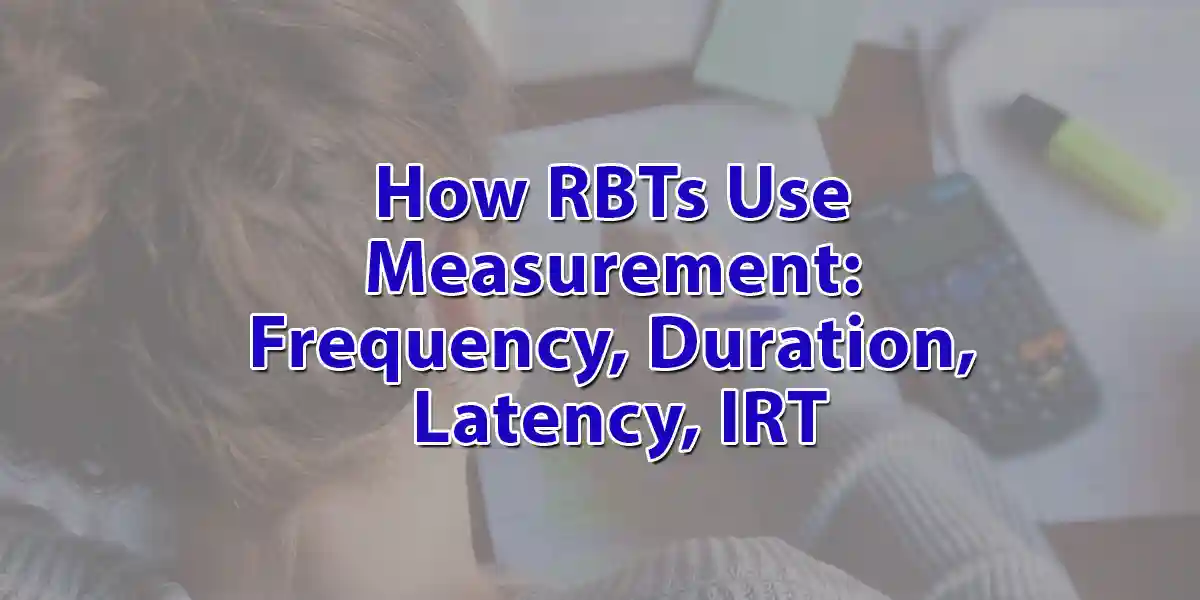In the field of Applied Behavior Analysis (ABA), Registered Behavior Technicians (RBTs) are the professionals on the ground implementing real change. Data supports every decision RBTs make, including interventions, praises, and plan adjustments. But data alone isn’t magic. The real power lies in accurate, reliable measurement of behaviors, which helps RBTs and their supervisors understand what’s working, what needs tweaking, and how clients are progressing.
Without measurement, ABA would be guesswork. But with consistent, well-chosen measurement systems, RBTs can objectively track everything from small improvements to breakthroughs. This article breaks down the four pillars of behavioral measurement—frequency, duration, latency, and interresponse time (IRT)—and explains exactly how RBTs use each one in daily practice.
What Is Behavioral Measurement in ABA?
Before jumping into each method, it helps to know what “measurement” means in ABA. In this field, measurement refers to the process of observing, recording, and quantifying behaviors so that progress can be analyzed objectively. Reliable measurement allows RBTs to:
- Document baseline performance.
- Monitor changes over time.
- Make data-driven decisions about interventions.
- Communicate progress clearly with supervisors and families.
Measurement can focus on behaviors we want to increase (like following instructions) as well as those we want to decrease (like aggression or elopement). RBTs work closely with BCBAs to decide which behaviors to measure and which tools to use.
Frequency: Counting How Often a Behavior Occurs
Frequency is perhaps the most intuitive form of measurement in ABA. It simply refers to the number of times a specific behavior happens within a given observation period.
Why Use Frequency?
Frequency is ideal for behaviors that are
- Easily counted.
- Have a clear start and end point.
- Occur at a manageable rate (not too fast to track).
How RBTs Collect Frequency Data
RBTs tally each occurrence of the behavior as it happens. The counting can be done using paper data sheets, clicker counters, or digital tools. At the end of the session, the total count is recorded.
Examples in Practice
- We are counting the number of times a student raises their hand during class.
- We are tracking the number of times a client requests a break.
- We document the frequency of a child’s self-harming actions.
Frequency Tips for RBTs
- Be precise: Only count the defined behavior.
- Use tallies, counters, or apps for quick data capture.
- Always set a clear observation period (e.g., “during math class” or “per hour”).
What Frequency Data Tells Us
Frequency data helps RBTs answer questions like
- Is the behavior increasing, decreasing, or staying the same over time?
- Are interventions making a noticeable difference?
- When and where does the behavior happen most often?
By looking at frequency trends on a graph, teams can quickly assess whether goals are being met or if plans need adjusting.
Duration: Measuring How Long a Behavior Lasts
Duration is the amount of time a behavior continues from start to finish. This measurement is especially useful when the length of the behavior (not just how often it happens) is important.
Why Use Duration?
Duration is ideal for behaviors that:
- Don’t have a clear count (e.g., “on-task” behavior).
- Measurements based on time, such as tantrums, reading, and attention span, hold greater significance.
How RBTs Collect Duration Data
- Start a stopwatch or timer as soon as the behavior begins.
- Stop the timer when the behavior ends.
- Record the elapsed time for each occurrence.
Some behaviors may require cumulative duration (total time across multiple instances in a session), while others use per-episode length (time per behavior event).
Examples in Practice
- We measure the duration a client stays seated during circle time.
- We record the duration of a child’s tantrum behavior.
- I am tracking the minutes spent independently reading.
Duration Tips for RBTs
- Use a reliable stopwatch, phone timer, or digital data system.
- Clearly define when the behavior starts and ends.
- Practice timing with supervisors or colleagues to ensure accuracy.
What Duration Data Tells Us
Duration data answers:
- Is the client able to sustain a skill or positive behavior for longer periods?
- Are challenging behaviors shortening as interventions progress?
- Does the client’s engagement fluctuate across different activities or times of day?
Duration gives a nuanced picture of behavioral change that frequency alone might miss.
Latency: Timing the Delay Between Request and Response
Latency measures the amount of time between a prompt, cue, or instruction and the initiation of the target behavior. This parameter tells us about responsiveness—how quickly a client begins to act after being prompted.
Why Use Latency?
Latency is valuable when:
- The speed of response is important (e.g., safety, compliance).
- Delays might signal avoidance or confusion.
- You want to see if interventions help clients respond faster.
How RBTs Collect Latency Data
- Please provide the instruction or cue.
- Start the timer immediately.
- Stop the timer when the client starts the behavior.
- Record the time interval.
Examples in Practice
- Timing how long it takes a student to start putting on their shoes after being told.
- The goal is to measure the delay between “line up” and lining up.
- We monitor the speed at which a client reacts to their name.
Latency Tips for RBTs
- Be consistent: Always measure latency from the same type of prompt.
- Use clear behavioral definitions for the “start” of the target response.
- Minimize distractions during the latency window.
What Latency Data Tells Us
Latency data shows:
- Is the client learning to follow instructions more promptly?
- Are certain instructions or settings associated with longer delays?
- Do changes in intervention (e.g., visual cues, reinforcement) reduce response time?
Latency helps teams identify and address issues like noncompliance, slow transitions, or processing delays.
Interresponse Time (IRT): Measuring Time Between Behaviors
Interresponse Time (IRT) is the elapsed time between two instances of the same behavior. This metric is critical when the spacing or pacing of behaviors matters.
Why Use IRT?
IRT is used when:
- Behaviors happen in rapid succession, and you want to slow them down.
- You want to increase intervals between behaviors (e.g., raising a hand, asking questions).
- Repetitive or compulsive behaviors need to be spaced out for safety or learning.
How RBTs Collect IRT Data
- Start the timer when one behavior instance ends.
- Stop the timer when the next instance begins.
- Record the interval.
- Calculate average or specific IRT as needed.
Examples in Practice
- The project involves measuring the time between each time a student leaves their seat.
- I am tracking the interval between questions asked during a lesson.
- We are recording the gap between self-injurious episodes.
IRT Tips for RBTs
- Carefully define the end of one response and the start of the next.
- Practice timing intervals with a supervisor to ensure accuracy.
- Use IRT alongside frequency data for richer analysis.
What IRT Data Tells Us
IRT helps answer:
- Are intervals between problem behaviors increasing with intervention?
- Is the client able to “wait” longer before repeating a behavior?
- Is there progress toward goals involving self-control or pacing?
IRT shines in settings where pacing and regulation are just as important as behavior reduction.
Choosing the Right Measurement for the Behavior
Not every behavior fits every measurement system. Here’s a quick guide for RBTs on picking the right approach:
- Frequency: For clear, countable behaviors.
- Duration: This is for behaviors that are best tracked over time.
- Latency: For situations where response speed matters.
- IRT: For analyzing the spacing or pacing of responses.
Collaborate with your BCBA supervisor to determine which measurement yields the most useful data for each target behavior. Occasionally, you’ll use two or more types together for a fuller picture.
Recording Data Accurately and Consistently
High-quality measurement isn’t just about using the right method—it’s about recording data reliably and consistently.
Keys to Reliable Data Collection:
- Clear operational definitions: Everyone must know exactly what to look for.
- Practice and calibration: RBTs may practice with supervisors or peers to ensure interobserver agreement.
- Minimize distractions: The more focused you are, the more accurate the data.
- Record data immediately. The sooner you record, the less likely you are to forget or miscount.
- Use effective tools: tallies, timers, clickers, or digital apps can make the process smoother.
Remember, reliable data is the only way to make sound, ethical decisions about a client’s plan and progress.
Using Measurement Data for Decision-Making
Once you’ve collected your frequency, duration, latency, and IRT data, what happens next? This stage is where RBTs shine as essential team members.
- Graphing and Analysis: Line graphs are the standard for graphing data, allowing for the visualization and discussion of trends during supervision.
- Progress Monitoring: RBTs and supervisors review data together to see if interventions are effective. Is the target behavior decreasing? Are new skills increasing?
- Plan Adjustments: If data shows a plateau or an unexpected trend, the team may adjust strategies, change reinforcement schedules, or revisit operational definitions.
- Family and Team Communication: Clear data helps RBTs show families and other team members exactly what’s happening, building trust and collaboration.
Common Mistakes and How to Avoid Them
Even experienced RBTs can make errors. Here’s how to sidestep the biggest pitfalls:
- Vague definitions: Always clarify what “counts” as the behavior.
- When counting partial or off-target behaviors, only include those that meet the established criteria.
- Timing errors: Practice starting/stopping timers promptly.
- Forgetting observation periods: Always note the exact window you’re watching.
- Not recording in real time: Delays can lead to missed or inaccurate data.
Ask for feedback, use checklists, and stay curious—these habits keep your data trustworthy.
Real-World Examples of Measurement in ABA Practice
Case Study 1: Reducing Elopement with Frequency Data
RBTs working with a client who frequently leaves their seat record each instance over several days. By graphing the frequency data, the team notices a pattern—elopement spikes after lunch. This insight helps the BCBA adjust the intervention to include a structured transition after meals, and frequency drops steadily.
Case Study 2: Increasing On-Task Behavior with Duration
A teenager with autism struggles to stay focused during homework. RBTs use duration data to track how long the teen remains engaged. Over time, the duration increases from three to twelve minutes per session, showing clear progress and helping celebrate small victories.
Case Study 3: Boosting Compliance Using Latency
In a classroom, a teacher wants students to start tasks more quickly. RBTs measure latency after giving the instruction, “Begin reading.” As the teacher adds visual supports and immediate praise, average latency drops from 30 seconds to 8 seconds—evidence that the intervention works.
Case Study 4: Managing Repetitive Behaviors with IRT
A child who repeatedly taps their desk during class becomes the focus of an IRT measurement. RBTs track the intervals between taps, using reinforcement to gradually lengthen the gaps. This strategy improves classroom focus and reduces disruption.
Conclusion: Measurement is the Key to Meaningful Change
For RBTs, measurement isn’t just a technical skill—it’s the engine driving real, positive change. By understanding and using frequency, duration, latency, and IRT, RBTs can turn observations into insight and insight into action. This toolkit empowers RBTs to individualize supports, celebrate every gain, and deliver ethical, high-quality care.
Whether you’re new to ABA or a seasoned pro, mastering these measurement tools ensures your clients get the best chance at growth, learning, and independence. The numbers may look simple, but behind every tally, timer, or interval is a story of hard work, collaboration, and hope.

